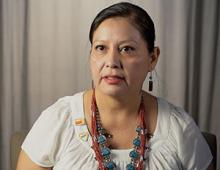Archival Notice
This is an archive page that is no longer being updated. It may contain outdated information and links may no longer function as originally intended.
Pamela Foster experienced every parent's worst nightmare.
On the afternoon of May 2, 2016, her 11-year-old daughter, Ashlynne Mike, and 9-year-old son, Ian Mike, didn't make it home from school. Instead, when they got off the school bus in Shiprock, New Mexico, on the Navajo Reservation, a predator tricked them into getting into his van. Hours later, passersby found Ian alone, wandering the desert. Police located Ashlynne's body the next day. She had been sexually assaulted, strangled and bludgeoned repeatedly with a tire iron.
"On this day a part of me died, and life has never been the same," said Ms. Foster. She spoke at the National AMBER Alert in Indian Country Symposium, held July 30 to August 1 in Albuquerque, New Mexico. The Office of Juvenile Justice and Delinquency Prevention, part of the Office of Justice Programs, administers the National AMBER Alert Training and Technical Assistance Program.
"The AMBER Alert program is vital to the safety of children," said Katie Sullivan, OJP's Principal Deputy Assistant Attorney General and National AMBER Alert Coordinator. "A positive outcome is never guaranteed, of course, but the statistics show that when AMBER Alert is part of the response, the odds are very high that an abducted child will come home safely. An immediate, full-scale response is critically important."
An AMBER Alert quickly broadcasts details of an abduction over mass media, highway digital signs and text messages. This early warning system—a powerful, modern alarm bell—activates an urgent bulletin to galvanize community support and bring a missing child home. Since its inception in 1996, the AMBER Alert program has helped 967 abducted children return home safely.
Although Ashlynne and Ian's parents made frantic efforts to find them, misunderstandings and jurisdictional hurdles on the reservation prevented an AMBER Alert from being issued until the next day, robbing authorities of critical hours in their search.
"I made a promise to [Ashlynne] that I would do my part to fix the loophole that exists in the system," said Ms. Foster. "I would fight for an AMBER Alert for Indian country."
Nearly two years after Ashlynne's death, Congress passed the Ashlynne Mike AMBER Alert in Indian Country Act The law enhances the training and technical assistance that tribes may receive and paves the way for tribes to access state AMBER Alert plans. This allows tribes to integrate their AMBER plans with those of the state or region. This ensures the broadest reach possible, should an AMBER Alert be necessary.
Since the Act's passage in 2018, the data show that while challenges remain, immense progress is taking place. Earlier this year, 100 federally recognized American Indian tribes representing 26 states responded to a national survey from the Justice Department. The department's report to Congress, "The Implementation of the Ashlynne Mike AMBER Alert in Indian Country Act," included the survey results and revealed that 76 tribes currently participate in a state or regional AMBER Alert plan.
The survey also found that tribes still face shortages of critical resources that would support their participation in AMBER Alert. These shortages include staffing; ongoing training and preparation in the investigation of child abductions; access to the criminal justice information systems where they can enter details about the missing child and suspect; and infrastructure, such as road signs, broadcasting capability, software and computers. Tribes also cited the challenge of their reservations' often large, diverse and remote geographic areas.
But the national assessment also revealed that tribes are committed to bringing AMBER Alerts to their communities. OJP will continue to support this commitment by helping tribes learn the value of AMBER Alerts; conducting meetings between tribes and their state or regional AMBER Alert officials; and providing training and technical assistance.
The recent symposium where Ms. Foster spoke was a key training opportunity. Tribal members, tribal partners, and the emergency management and law enforcement professionals who attended learned about the AMBER Alert process, the role of the state AMBER Alert Coordinator and how the Navajo Nation—Ashlynne's tribe—developed its program. They heard about available resources and ongoing support funded by OJJDP, and could network with other tribal members also on this journey.
"Although Ashlynne is no longer physically here with us, she is still working for us. Long after I am gone her work will still be in action," Ms. Foster said at the symposium. "It is through the love we have for our little girl that we have moved mountains, and I am thankful her legacy will be remembered."





